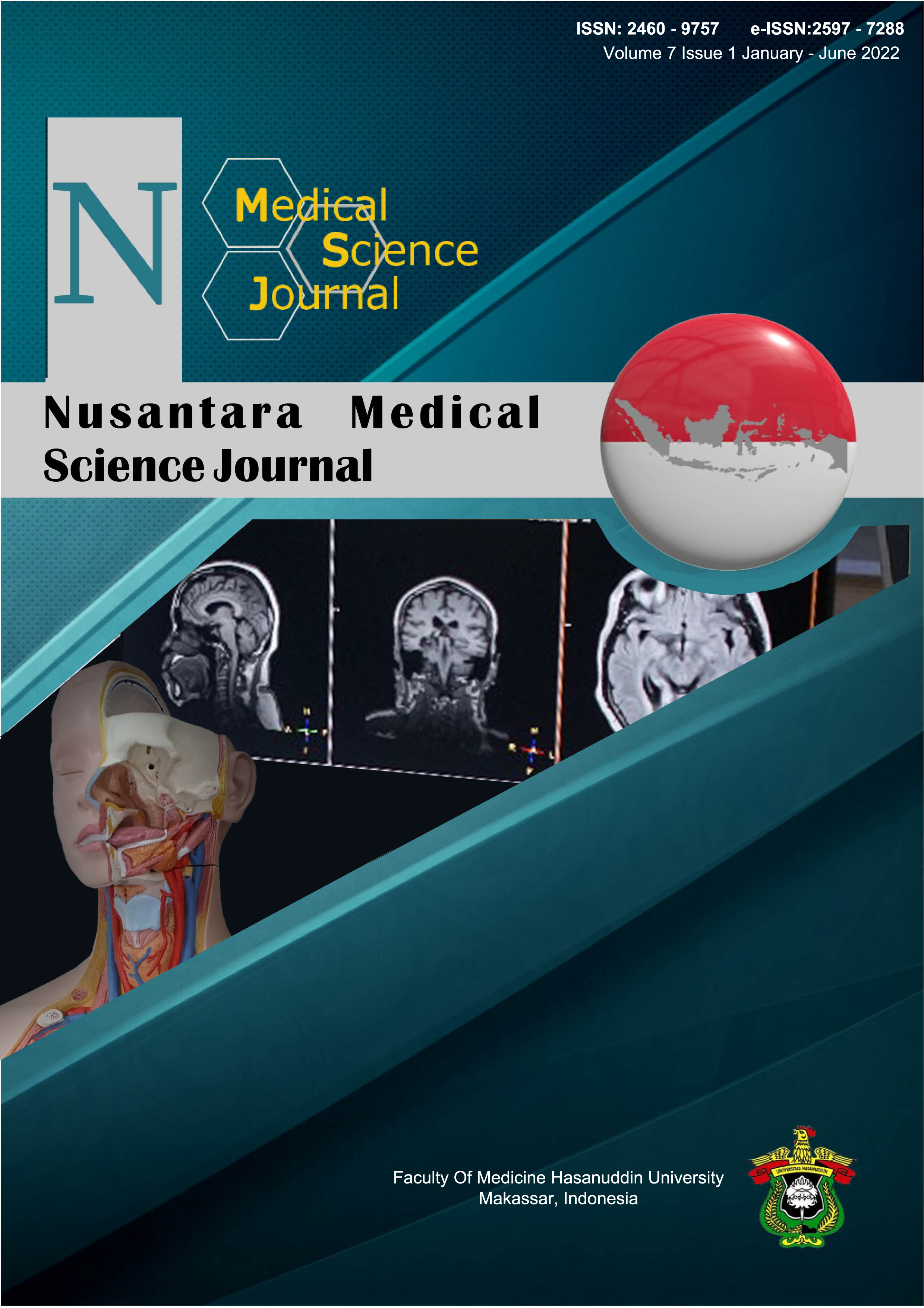Survivability Rates Based on Molecular Subtype, Stage and Metastasis of 36 months cohort in Breast Cancer Patients
DOI:
https://doi.org/10.20956/nmsj.v7i1.20092Abstract
Introduction: Breast cancer treatment is carried out at the early stage of the disease, and a comprehensive assessment of the subtype, stage, and incidence of metastases is required. This study aims to determine breast cancer patients' overall survival (OS) and disease-free survival (DFS) based on subtype, stage, and incidence of metastases. Methods: An observational analytic study with a retrospective cohort design was performed on eligible breast cancer patients at Wahidin Sudirohusodo Hospital from 2016 to 2019. Univariate analysis, and the Kaplan-Meier survival log-rank method (Mantel-Cox), were used to determine differences in survivability rates (OS and DFS) based on subtype, stage, and incidence of metastases. Results: A total of 172 breast cancer patients from 32 years to 84 years with a mean age of 53.5 years. The most subtypes were Luminal A (34.9%) patients, and the least was Luminal B (15.7%) patients. A total of 85 (49.4%) patients survived during these three years, while 87 (50.6%) died. Based on the results of statistical tests in this study, there were no significant differences between the subtypes with DFS and OS, but on the contrary, there was a significant difference between the stage and incidence of metastases with OS and DFS (p<0.05). Conclusions: There were no statistically significant differences between the subtypes with OS and DFS. This study showed a significant difference between the stage and incidence of metastases with OS and DFS
References
Ghoncheh M, Mahdavifar N, Darvishi E, Salehiniya H. Epidemiology, Incidence and Mortality of Breast Cancer in Asia. Asian Pac J Cancer Prev. 2016;17(sup3):47-52. doi:10.7314/APJCP.2016.17.S3.47
The International Agency for Research onCancer (IARC). Global Cancer Observatory. Accessed February 20, 2022. https://gco.iarc.fr/
Health Department of South Sulawesi Province. 2014 Non-Communicable Disease Case Report. Published online 2014.
Nguyen D, Yu J, Reinhold WC, Yang SX. Association of Independent Prognostic Factors and Treatment Modality With Survival and Recurrence Outcomes in Breast Cancer. JAMA Netw Open. 2020;3(7):e207213. doi:10.1001/jamanetworkopen.2020.7213
Ginsburg O, Yip CH, Brooks A, et al. Breast cancer early detection: A phased approach to implementation. Cancer. 2020;126(S10):2379-2393. doi:10.1002/cncr.32887
Yersal O, Barutca S. Biological subtypes of breast cancer: Prognostic and therapeutic implications. World J Clin Oncol. 2014;5(3):412-424. doi:10.5306/wjco.v5.i3.412
Goldhirsch A, Winer EP, Coates AS, et al. Personalizing the treatment of women with early breast cancer: highlights of the St Gallen International Expert Consensus on the Primary Therapy of Early Breast Cancer 2013. Ann Oncol Off J Eur Soc Med Oncol. 2013;24(9):2206-2223. doi:10.1093/annonc/mdt303
Arnone P, Zurrida S, Viale G, et al. The TNM classification of breast cancer: need for change. Updat Surg. 2010;62(2):75-81. doi:10.1007/s13304-010-0014-y
Kimbung S, Loman N, Hedenfalk I. Clinical and molecular complexity of breast cancer metastases. Semin Cancer Biol. 2015;35:85-95. doi:10.1016/j.semcancer.2015.08.009
McPherson K, Steel CM, Dixon JM. ABC of breast diseases. Breast cancer-epidemiology, risk factors, and genetics. BMJ. 2000;321(7261):624-628. doi:10.1136/bmj.321.7261.624
Su Y, Zheng Y, Zheng W, et al. Distinct distribution and prognostic significance of molecular subtypes of breast cancer in Chinese women: a population-based cohort study. BMC Cancer. 2011;11:292. doi:10.1186/1471-2407-11-292
Kennecke H, Yerushalmi R, Woods R, et al. Metastatic Behavior of Breast Cancer Subtypes. J Clin Oncol. 2010;28(20):3271-3277. doi:10.1200/JCO.2009.25.9820
Wang R, Zhu Y, Liu X, Liao X, He J, Niu L. The Clinicopathological features and survival outcomes of patients with different metastatic sites in stage IV breast cancer. BMC Cancer. 2019;19(1):1091. doi:10.1186/s12885-019-6311-z
Simon SD, Bines J, Werutsky G, et al. Characteristics and prognosis of stage I-III breast cancer subtypes in Brazil: The AMAZONA retrospective cohort study. Breast Edinb Scotl. 2019;44:113-119. doi:10.1016/j.breast.2019.01.008
Zegarac M, Nikolic S, Gavrilovic D, et al. Prognostic factors for longer disease free survival and overall survival after surgical resection of isolated liver metastasis from breast cancer. J BUON Off J Balk Union Oncol. 2013;18(4):859-865.
Downloads
Published
How to Cite
Issue
Section
License
Copyright (c) 2022 Nusantara Medical Science Journal

This work is licensed under a Creative Commons Attribution 4.0 International License.









